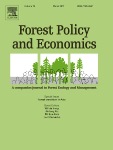Spatially explicit demand for afforestation
Afforestation is a stated goal in European Union policy and several member states have already implemented schemes to extend forest cover. However, little is known about the magnitude of non-market benefits of afforestation and how these benefits spatially differ. In this article, we propose a novel method to spatially explicitly predict marginal willingness to pay for afforestation. The approach is illustrated with data from a discrete choice experiment on local land use changes in Germany. GIS data on the respondent's place of residence allows inferring their current endowment with forest, which enters the utility specification of each respondent's status quo alternative. Marginal willingness to pay estimates therefore represent the value of changes in local forest cover relative to the observed status quo. This relationship can be utilized to predict willingness to pay at the county level. We find that marginal willingness to pay decreases as the current endowment with forest increases. The estimated optimal share of forest based on the average respondent's preferences is between 50 and 60%. The associated county level predictions of marginal and total willingness to pay can be used to inform national, regional and local policies that aim to increase forest cover.
<link http: www.sciencedirect.com science article pii s1389934117300680 external-link-new-window external link in new>More Information and Download



